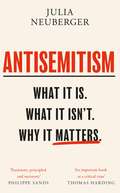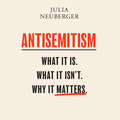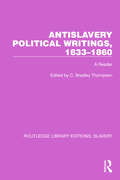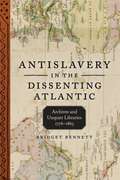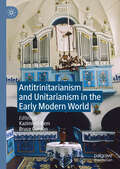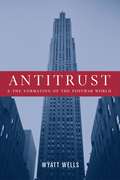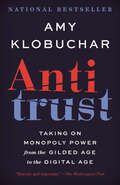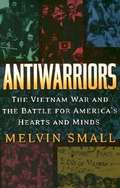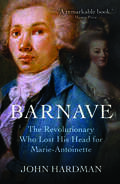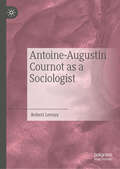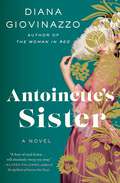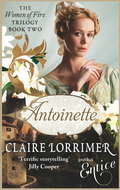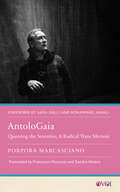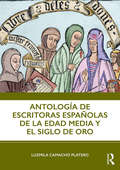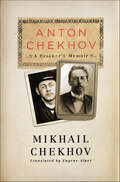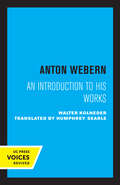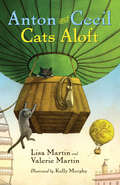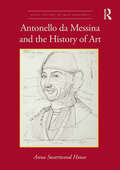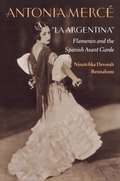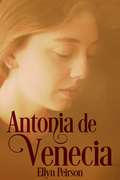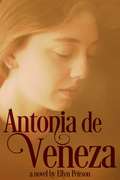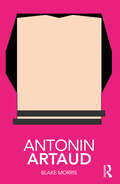- Table View
- List View
Antisemitism: What It Is. What It Isn't. Why It Matters
by Julia NeubergerAntisemitism has been on the rise in recent years, with violent attacks, increased verbal insults, and an acceptability in some circles of what would hitherto have been condemned as outrageous antisemitic discourse. Yet despite the dramatic increase in debate and discussion around antisemitism, many of us remain confused. In this urgent and timely book, Rabbi Julia Neuberger uses contemporary examples, along with historical context, to unpack what constitutes antisemitism, building a powerful argument for why it is so crucial that we come to a shared understanding now.
Antisemitism: What It Is. What It Isn't. Why It Matters
by Julia NeubergerThere has been a disturbing rise in antisemitism in Europe over the last fifteen years or so, with violent attacks on Jewish targets, increased verbal antisemitism, and an acceptability in many circles of what would hitherto have been condemned as outrageous antisemitic discourse. More recently, the Labour party have come under fire for engaging in antisemitic abuse. Yet despite the dramatic increase in debate and discussion around antisemitism, there is a general sense of confusion about what should and shouldn't be defined as antisemitism - and particularly around criticism of the State of Israel.In this urgently needed book, Rabbi Julia Neuberger uses contemporary examples, along with historical context, to unpack what constitutes antisemitism, building a powerful argument for why it is so crucial that we come to a shared understanding now, and exploring ways of dealing with it.
Antisemitism: What It Is. What It Isn't. Why It Matters
by Julia NeubergerThere has been a disturbing rise in antisemitism in Europe over the last fifteen years or so, with violent attacks on Jewish targets, increased verbal antisemitism, and an acceptability in many circles of what would hitherto have been condemned as outrageous antisemitic discourse. More recently, the Labour party have come under fire for engaging in antisemitic abuse. Yet despite the dramatic increase in debate and discussion around antisemitism, there is a general sense of confusion about what should and shouldn't be defined as antisemitism - and particularly around criticism of the State of Israel.In this urgently needed book, Rabbi Julia Neuberger uses contemporary examples, along with historical context, to unpack what constitutes antisemitism, building a powerful argument for why it is so crucial that we come to a shared understanding now, and exploring ways of dealing with it.
Antislavery Political Writings, 1833–1860: A Reader (Routledge Library Editions: Slavery #3)
by Thompson C. BradleyAntislavery Political Writings, first published in 2004, presents the best speeches and writings of the leading American antislavery thinkers, activists and politicians in the years between 1830 and 1860. These chapters demonstrate the range of theoretical and political choices open to antislavery advocates during the antebellum period.
Antislavery in the Dissenting Atlantic: Archives and Unquiet Libraries, 1776–1865 (Antislavery, Abolition, and the Atlantic World)
by Bridget BennettBridget Bennett’s Antislavery in the Dissenting Atlantic explores the impact of a historically situated set of transatlantic networks, chiefly centered on prominent communities of religious nonconformists in England and Pennsylvania in the decades between the American Revolution and American Civil War. The study reveals the alliances forged out of progressive religious and political commitments to dissent that enabled expansive connections across the Atlantic world. These developments emerged from local proximities and combined an optimistic devotion to social justice and education with a global vision. Bennett’s work offers an original and innovative reading of transatlantic partnerships, exploring obscure writings, overlooked individuals, and the cultures of the everyday, while also affording fresh understandings of familiar antislavery texts.
Antitrinitarianism and Unitarianism in the Early Modern World
by Bruce Gordon Kazimierz BemThis collection offers an innovative and fresh interpretation of Antitrinitarian and rational dissent in the early modern world. The central themes focus on the fierce debates surrounding Antitrinitarianism and Unitarianism that emerged from the Reformation and the lived cultures of these dissenting movements. The chapters take an interdisciplinary approach addressing ideas in context, their reception and appropriation, and the diverse and often conflicting visions of Christianity. Drawing on previously unused sources, many from Eastern Europe and often in inaccessible languages, this book challenges our understanding of dissent as marginal and eccentric and places it at the center of contesting convictions about the nature of religious reform.
Antitrust and the Formation of the Postwar World (Columbia Studies in Contemporary American History)
by Wyatt WellsToday antitrust law shapes the policy of almost every large company, no matter where headquartered. But this wasn't always the case. Before World War II, the laws of most industrial countries tolerated and even encouraged cartels, whereas American statutes banned them. In the wake of World War II, the United States devoted considerable resources to building a liberal economic order, which Washington believed was necessary to preserving not only prosperity but also peace after the war. Antitrust was a cornerstone of that policy. <P><P>This fascinating book shows how the United States sought to impose—and with what results—its antitrust policy on other nations, especially in Europe and Japan. Wyatt Wells chronicles how the attack on cartels and monopoly abroad affected everything from energy policy and trade negotiations to the occupation of Germany and Japan. He shows how a small group of zealots led by Thurman Arnold, who became head of the Justice Department's Antitrust Division in 1938, targeted cartels and large companies throughout the world: IG Farben of Germany, Mitsui and Mitsubishi of Japan, Imperial Chemical Industries of Britain, Philips of the Netherlands, DuPont and General Electric of the United States, and more. Wells brilliantly shows how subsequently, the architects of the postwar economy—notably Lucius Clay, John McCloy, William Clayton, Jean Monnet, and Ludwig Erhard—uncoupled political ideology from antitrust policy, transforming Arnold's effort into a means to promote business efficiency and encourage competition.
Antitrust: Taking on Monopoly Power from the Gilded Age to the Digital Age
by Amy KlobucharAntitrust enforcement is one of the most pressing issues facing America today—and Amy Klobuchar, the widely respected senior senator from Minnesota, is leading the charge. This fascinating history of the antitrust movement shows us what led to the present moment and offers achievable solutions to prevent monopolies, promote business competition, and encourage innovation. <P><P>In a world where Google reportedly controls 90 percent of the search engine market and Big Pharma’s drug price hikes impact healthcare accessibility, monopolies can hurt consumers and cause marketplace stagnation. Klobuchar—the much-admired former candidate for president of the United States—argues for swift, sweeping reform in economic, legislative, social welfare, and human rights policies, and describes plans, ideas, and legislative proposals designed to strengthen antitrust laws and antitrust enforcement. <P>Klobuchar writes of the historic and current fights against monopolies in America, from Standard Oil and the Sherman Anti-Trust Act to the Progressive Era's trust-busters; from the breakup of Ma Bell (formerly the world's biggest company and largest private telephone system) to the pricing monopoly of Big Pharma and the future of the giant tech companies like Facebook, Amazon, and Google. She begins with the Gilded Age (1870s-1900), when builders of fortunes and rapacious robber barons such as J. P. Morgan, John Rockefeller, and Cornelius Vanderbilt were reaping vast fortunes as industrialization swept across the American landscape, with the rich getting vastly richer and the poor, poorer. <P><P>She discusses President Theodore Roosevelt, who, during the Progressive Era (1890s-1920), "busted" the trusts, breaking up monopolies; the Clayton Act of 1914; the Federal Trade Commission Act of 1914; and the Celler-Kefauver Act of 1950, which it strengthened the Clayton Act. She explores today's Big Pharma and its price-gouging; and tech, television, content, and agriculture communities and how a marketplace with few players, or one in which one company dominates distribution, can hurt consumer prices and stifle innovation. <P><P>As the ranking member of the Senate Judiciary Subcommittee on Antitrust, Competition Policy, and Consumer Rights, Klobuchar provides a fascinating exploration of antitrust in America and offers a way forward to protect all Americans from the dangers of curtailed competition, and from vast information gathering, through monopolies. <P><P><b>A New York Times Best Seller</b>
Antiwarriors: The Vietnam War and the Battle for America's Hearts and Minds
by Melvin SmallThe antiwar movement comes to life in this compelling new book that is sure to fascinate all those interested in the Vietnam War and the turbulent, tumultuous 1960s.
Antoine Barnave: The Revolutionary who Lost his Head for Marie Antoinette
by John HardmanA major new biography of Antoine Barnave—the politician and writer who advocated for a constitutional monarchy in revolutionary France Antoine Barnave was one of the most influential statesmen in the early French Revolution. He was a didactic man of austere morals and vaulting ambition who dressed as an English dandy, running up considerable tailor’s bills. Before his execution at age thirty-two, he played a decisive role in revolutionary politics and even governed France in 1791 through a secret correspondence with Marie-Antoinette. In the first biography for more than a century, John Hardman traces Barnave’s life from his youth in Dauphiné to his role in the Constituent Assembly and his part in forming the Feuillants, the party dedicated to the moderate cause. Despite his early death, Barnave left a remarkable volume of material, from published works to thousands of manuscript pages. Hardman uses this rich archive to explore the life of this elusive writer, politician, and thinker—and sheds new light on the revolutionary period.
Antoine-Augustin Cournot as a Sociologist
by Robert LerouxThe thinking of Antoine-Augustin Cournot has inspired a growing literature in economy and epistemology, but as of yet, his sociological thought has not been explicitly discussed and contextualized within the discipline. From the 1850s to the end of the 1870s, Cournot contributed significantly to the history of French sociology, particularly in the development of one essential idea: that forms of knowledge are intimately linked to the progress of reason. Philosophy, therefore, becomes interested in the development of the sciences, evolving as they do from the process of rationalizing human societies. Cournot’s comparative-historical sociology, “rediscovered” especially by Gabriel Tarde in the 20th century, seeks to understand how a macro-sociological trend can depend on the aggregation of a host individual decisions and actions, or to discern a certain order out of apparent chaos.
Antoinette's Sister
by Diana GiovinazzoAs Marie Antoinette took her last breath as Queen of France in Paris, another formidable monarch—Antoinette&’s dearly beloved sister, Charlotte—was hundreds of miles away, in Naples, fighting desperately to secure her release from the revolutionaries who would take her life. Little did Charlotte know, however, that her sister&’s execution would change the course of history—and bring about the end of her own empire. A Pennie's Pick book club selection. &“You are the queen. You are the queen that Antoinette wanted to be.&” Austria 1767: Maria Carolina Charlotte—tenth daughter and one of sixteen children of Empress Maria Theresa of Austria—knows her position as a Habsburg archduchess will inevitably force her to leave her home, her family, and her cherished sister, Antoinette, whose companionship she values over all else. But not yet. The Habsburg family is celebrating a great triumph: Charlotte&’s older sister, Josepha, has been promised to King Ferdinand IV of Naples and will soon take her place as queen. Before she can journey to her new home, however, tragedy strikes. After visiting the family crypt, Josepha contracts smallpox and dies. Shocked, Charlotte is forced to face an unthinkable new reality: she must now marry Ferdinand in her sister&’s stead. Bereft and alone, Charlotte finds that her life in Naples is more complicated than she could ever have imagined. Ferdinand is weak and feckless, and a disastrous wedding night plunges her into despair. Her husband&’s regent, Tanucci, a controlling and power-hungry man, has pushed the country to the brink of ruin. Overwhelmed, she asks her brother Leopold, now the Holy Roman Emperor, to send help—which he does in the form of John Acton, a handsome military man twenty years Charlotte&’s senior who is tasked with overseeing the Navy. Now, Charlotte must gather the strength to do what her mother did before her: take control of a country. In a time of political uprisings and royal executions and with the increasingly desperate crisis her favorite sister, Queen Marie Antoinette, is facing in France, how is a young monarch to keep hold of everything—and everyone—she loves? Find out in this sweeping, luxurious tale of family, court intrigue, and power.Includes a Reading Group Guide.
Antoinette: Book Two
by Claire LorrimerAntoinette, daughter of the beautiful Scarlett and a French Vicomte, has inherited her mother's exquisite beauty and her passionate, impulsive nature. But the two women are rivals. Antoinette is irresistibly drawn to her mother's former lover, Sir Peregrine Waite. But he only sees her as a child and does not yield to her loving advances.Burning with fury and humiliation at his rejection, Antoinette becomes involved with a notorious philanderer and finds herself plunged into disgrace and degradation. And despite the dangerous secret she discovers, her love for Sir Peregrine remains. Set against a stunning background of the wealthy and priveleged in Europe, this is a scorching, tempestuous sequel to SCARLETT.
Antoinette: Number 2 in series (Women of Fire Trilogy #2)
by Claire LorrimerAntoinette, daughter of the beautiful Scarlett and a French Vicomte, has inherited her mother's exquisite beauty and her passionate, impulsive nature. But the two women are rivals. Antoinette is irresistibly drawn to her mother's former lover, Sir Peregrine Waite. But he only sees her as a child and does not yield to her loving advances.Burning with fury and humiliation at his rejection, Antoinette becomes involved with a notorious philanderer and finds herself plunged into disgrace and degradation. And despite the dangerous secret she discovers, her love for Sir Peregrine remains. Set against a stunning background of the wealthy and priveleged in Europe, this is a scorching, tempestuous sequel to SCARLETT.
AntoloGaia: Queering the Seventies, A Radical Trans Memoir (Other Voices of Italy)
by Porpora MarcascianoIn this stirring memoir by a member of the first generation of LGBTQ+ activists in Italy, Porpora Marcasciano tells her story and shares the struggles and accomplishments of her fellow activists who achieved so much in the 1970s yet suffered devastating losses during the AIDS epidemic of the 1980s. AntoloGaia offers an insider’s look at the beginnings of the gay liberation movement in Italy and reveals how it was intimately intertwined with other forms of left-wing activism. At the same time, it powerfully conveys the queer joy of a young person from a small village first encountering the vibrant sexual minority communities of Naples, Bologna, and Rome. As Marcasciano starts to embrace her trans identity, she meets the famous anthropologist Pino Simonelli, who introduces her to Naples’s unique femminielli subculture and gives her the name Porporino, which she later shortens to Porpora. In keeping with this story of gender, sexual, and political discovery, AntoloGaia is the first piece of Italian life-writing to use gender-neutral and mixed-gender language.
Antología de escritoras españolas de la Edad Media y el Siglo de Oro
by Luzmila Camacho Platero; Javier Muñoz-BasolsAntología de escritoras españolas de la Edad Media y el Siglo de Oro ofrece una selección de obras literarias de ocho escritoras medievales, renacentistas y barrocas. Cada capítulo presenta una extensa introducción sobre la autora y su obra. Esta antología contribuye a mejorar el conocimiento de los estudiantes sobre la lengua, la literatura y la cultura españolas, al igual que ofrece una lectura desde la perspectiva de género de estas escritoras. Acompañada de textos originales modernizados al castellano actual, notas aclaratorias, actividades y una extensa y actualizada bibliografía, Antología de escritoras españolas de la Edad Media y el Siglo de Oro muestra la evolución de voces femeninas a lo largo de estos siglos. Las actividades sugeridas para cada capítulo ayudan a exponer y a reflexionar sobre la relevancia cultural que en la actualidad tienen los argumentos que estas mujeres proponent en sus trabajos. Esta antología será de gran utilidad para estudiantes de literatura y cultura españolas de niveles de grado y graduado e, igualmente, para los estudiantes hispanohablantes de literature comparada y de estudios de género.
Anton Chekhov: A Brother's Memoir
by Mikhail ChekhovIn a style reminiscent of Anton Chekhov himself--realistic, intimate, and dynamic--Mikhail Chekhov shares unparalleled memories and insights, transporting readers into the world of the Chekhov family. He visits the places where his brother lived and worked and introduces the people he knew and loved, Leo Tolstoy and Piotr Tchaikovsky among them. As a unique eyewitness to the beloved writer's formative years and his artistic maturity, Mikhail Chekhov shows here first-hand the events that inspired the plots for The Seagull, The Black Monk, and The Steppe, among other enduring works. Captivating, surprising, and a joy to read, this memoir reveals the remarkable life of one the most masterful storytellers of our time.
Anton Webern: An Introduction to His Works
by Walter KolnederThis title is part of UC Press's Voices Revived program, which commemorates University of California Press’s mission to seek out and cultivate the brightest minds and give them voice, reach, and impact. Drawing on a backlist dating to 1893, Voices Revived makes high-quality, peer-reviewed scholarship accessible once again using print-on-demand technology. This title was originally published in 1968.
Anton and Cecil, Book 3: Cats Aloft (Anton and Cecil #3)
by Valerie Martin Kelly Murphy Lisa MartinTuckered out from a journey across the Wild West, cat brothers Anton and Cecil are ready to head east for home--until a minor stop to change trains in Chicago turns into a major adventure. A bloodhound detective recruits the brothers to help solve a case: puppies are disappearing right off their leashes! Anton and Cecil’s search takes them deep into the heart of the 1893 Chicago World’s Fair, where they befriend exotic animals, ride the newly invented Ferris Wheel, and look for clues amid the crowds of fairgoers. Just as they close in on the culprit, Cecil is carried away in a giant flying balloon and Anton is left behind. Can the cat brothers find the puppies and each other in this big, busy city? Fans of classic animal adventures such as A Cricket in Times Square and Poppy will love Anton and Cecil’s world, brimming with action and rich, true-to-life detail.
Antonello da Messina and the History of Art (Visual Culture in Early Modernity)
by Anna Swartwood HouseThis book argues that painter Antonello da Messina (c. 1430–1479) is a formative cross-cultural figure in the practice of art history itself.Featuring new interpretations of some of his best-known works, Anna Swartwood House shows how the uncertainties surrounding the painter have made him a uniquely pliable figure, easily inserted into different narratives of contact, cultural translation, and exchange. Using a wide range of materials including archival documents, biographies, civic histories, collectors’ notes, and popular literature, House traces the fortunes of an artist continually defined by place.The book will be of interest to scholars working in art history, Renaissance studies, early modern history, and historiography.
Antonia Mercé, “LaArgentina”: Flamenco and the Spanish Avant Garde
by Ninotchka BennahumAntonia Mercé, stage-named La Argentina, was the most celebrated Spanish dancer of the early 20th century. Her intensive musical and theatrical collaborations with members of the Spanish vanguard -- Manuel de Falla, Frederico García Lorca, Enrique Granados, Néstor de la Torre, Joaquín Nín, and with renowned Andalusian Gypsy dancers -- reflect her importance as an artistic symbol for contemporary Spain and its cultural history. When she died in 1936, newspapers around the world mourned the passing of the "Flamenco Pavlova."
Antonia de Venecia
by Ana Rubio-Serrano Ellyn PeirsonMuy pocas personas conocían a Antonia, a pesar de su eventual fama como "La Estrella de Venecia". Antonia de Venecia es una revelación del amor, de las almas conectadas, de la música, del poder y de la tragedia. La historia atrae al lector en la belleza y la decadencia de la Venecia del siglo XVIII, y en las pasiones que conducen y atormentan a sus personajes. Antonia pasa de ser la alumna estrella de Vivaldi a convertirse en su colega musical y el orgullo de la vanidad musical veneciana. Después de que ella se enamorara de Orlando Sagredo, el maestro organizador del Palio, Antonia reconoce la esclavitud emocional que nunca había cuestionado. Antonia de Venecia está habitada por músicos brillantes, políticos avaros y gobernantes ineficaces de la República de Venecia. A través de todo este entramado, la gente y la música que Antonia ama lleva al lector a las profundidades de la venganza y el sacrificio. Una novela romántica, bien documentada, del siglo XVIII con descripciones brillantes. Antonia de Venecia avanza el eterno femenino heroico como un socio poderoso e igual al masculino.
Antonia de Veneza
by Adelaide Franco Nikolic Ellyn PeirsonMuito poucas pessoas conheceram Antonia, apesar da fama alcançada como “La Stella di Venezia”. Antonia de Veneza é um romance que fala de amor, almas gémeas, música, poder e tragédia. A história atrai o leitor para a beleza e a decadência da Veneza do século XVIII e para as paixões que impulsionam e atormentam os seus personagens. Antonia evolui de aluna prodígio de Vivaldi a sua colega musical e ao orgulho da vaidade musical veneziana. Depois de se apaixonar por Orlando Sagredo, o mestre planeador do Palio, Antonia reconhece a escravidão emocional que, até então, nunca questionou. Antonia de Veneza é habitada por músicos brilhantes, políticos avarentos e governantes inúteis da República de Veneza. Ao mesmo tempo, as pessoas e a música que Antonia ama levam o leitor numa viagem às profundezas da vingança e da abnegação. Um romance bem pesquisado, passado no século XVIII, com descrições brilhantes, Antonia de Veneza apresenta a heroína feminina intemporal como uma parceira poderosa e igual ao seu oposto masculino.
Antonietta
by John HerseyA saga of a magnificent violin, "Antonietta", named after a beautiful woman who was the inspiration of Antonio Stradivari's later years. As Hersey brings Mozart, Berlioz, and Stravinsky to life, he offers us a marvelous celebration of the changing character and eternal art and power of music.
Antonin Artaud (Routledge Performance Practitioners)
by Blake MorrisRoutledge Performance Practitioners is a series of introductory guides to the key theatre-makers of the last century. Each volume explains the background to and the work of one of the major influences on twentieth- and twenty-first-century performance. Antonin Artaud was an active theatre-maker and theorist whose ideas reshaped contemporary approaches to performance. This is the first book to combine an overview of Artaud’s life with a focus on his work as an actor and director; an analysis of his key theories, including the Theatre of Cruelty and the double; a consideration of his work as a director at the Théâtre Alfred Jarry and his production of Strindberg’s A Dream Play; and a series of practical exercises to develop an approach to theatre based on Artaud’s key ideas. As a first step towards critical understanding and as an initial exploration before going on to further, primary research, Routledge Performance Practitioners are unbeatable value for today’s student.
